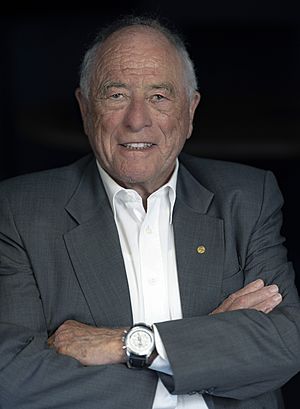Kurt Wüthrich facts for kids
Quick facts for kids
Kurt Wüthrich
|
|
|---|---|

Wüthrich in 2022
|
|
| Born | 4 October 1938 |
| Alma mater | |
| Known for | Protein NMR Transverse relaxation-optimized spectroscopy ST2-PT |
| Awards |
|
| Scientific career | |
| Fields | |
| Institutions |
|
| Doctoral advisor | Silvio Fallab |
Kurt Wüthrich is a famous Swiss scientist. He was born on October 4, 1938, in Aarberg, Switzerland. He is a chemist and biophysicist. Dr. Wüthrich won the Nobel Prize in Chemistry in 2002. He is known for creating special ways to study tiny parts of living things. These methods use something called nuclear magnetic resonance (NMR).
Contents
Early Life and Learning
Kurt Wüthrich grew up in Aarberg, Switzerland. He went to the University of Bern. There, he studied chemistry, physics, and mathematics. After that, he continued his studies at the University of Basel. He earned his PhD degree in 1964. His research was about how certain copper compounds help chemical reactions.
A Career in Science
After finishing his PhD, Dr. Wüthrich traveled to the United States. From 1965 to 1967, he worked at the University of California, Berkeley. He then moved to Bell Labs in New Jersey. Bell Labs was a very important research center. There, he started using a new and powerful tool called a superconducting NMR spectrometer. This is where he began studying the structure of proteins. Proteins are the building blocks of life.
In 1969, Dr. Wüthrich returned to Switzerland. He joined the ETH Zürich university. He became a Professor of Biophysics in 1980. He still has a research lab at ETH Zürich today. He also works at The Scripps Research Institute in California. More recently, he has a lab at ShanghaiTech University in China. He has also been a visiting professor at other universities. These include the University of Edinburgh and the Chinese University of Hong Kong.
How He Studied Proteins
When Dr. Wüthrich was a student, he first worked with a method called electron paramagnetic resonance. Later, in California, he started using nuclear magnetic resonance spectroscopy. This method helps scientists understand how atoms are arranged in molecules.
Back in Switzerland, Dr. Wüthrich worked with another Nobel Prize winner, Richard R. Ernst. Together, they helped create new ways to use NMR. They found a way to measure distances between atoms inside proteins. This was a huge step forward. It allowed scientists to figure out the exact 3D shapes of proteins. Knowing a protein's shape helps us understand how it works.
Sharing Science with Young People
Dr. Wüthrich cares about teaching science to young people. In 2010, he took part in a special program. It was called "Lunch with a Laureate." Middle and high school students got to eat lunch with him. They could ask him questions about science and his work. He also supports groups that want to improve how the United Nations works.
Awards and Special Recognition
Dr. Wüthrich has received many important awards for his scientific work.
- In 1991, he won the Louisa Gross Horwitz Prize.
- In 1993, he received the Louis-Jeantet Prize for Medicine.
- In 1999, he was given the Otto Warburg Medal.
- In 2002, he won half of the Nobel Prize in Chemistry. He received it for his work on using NMR to find the 3D shapes of large biological molecules.
- In 2010, he became a Foreign Member of the Royal Society. This is a very respected science group in the United Kingdom.
- In 2018, he received the Fray International Sustainability Award.
Life in Shanghai
On April 2, 2018, Dr. Wüthrich moved to Shanghai, China. He now lives there permanently.
See also
 In Spanish: Kurt Wüthrich para niños
In Spanish: Kurt Wüthrich para niños

